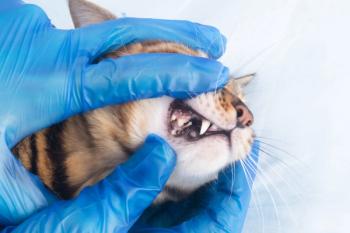
Dental anatomy and charting (Proceedings)
One of the first skills taught in veterinary dentistry is how to properly chart a mouth.
One of the first skills taught in veterinary dentistry is how to properly chart a mouth. This enables the technician to make "short hand" notes regarding every aspect of the patient's mouth seen today as a part of the permanent record. This reveals how the patient's mouth looked during the exam, and what work was accomplished. It is important that this be organized, neat, consistent with standard charting methods, and thorough. Once completed, this chart becomes a part of the medical record and thus a legal document.
Choose a chart that has a graphic representation (picture) of a patient's full dentition. A canine dental chart will be different and not interchangeable with that of a feline. It should have plenty of room for, patient identification and signalment, notes regarding signs, diagnosis, and treatment plan. There should also be an area for comments, and home care.
But, before we begin charting, it is very important that you know how many teeth a puppy or kitten is supposed to have or an adult dog or cat. The dental formulae are as follows:
• Adult dog: I 3/3, C 1/1, P 4/4, M 2/3
o Deciduous dog: i 3/3, c 1/1, p 3/3
• Adult cat: I 3/3, C 1/1, P 3/2, M 1/1
o Deciduous cat: i 3/3, c 1/1, p 3/2
Prior to anesthesia, the head should be assessed. Look for facial asymmetries, wounds, and ability to properly close the mouth, crepitus and bite. It is often difficult to assess the bite when the patient is asleep and the tongue is in the way. Also, be sure to check lymph nodes size. If the patient is very wiggly, sedation may be needed to accomplish some of these assessments.
Then, once your patient is properly anesthetized, a thorough intra-oral examination can take place. Many prefer to chart prior to cleaning. This can reveal teeth that require little cleaning effort due to advanced pathology, therefore reducing the cleaning and anesthesia time required. Again, it is important to develop a routine that works best for you so that charting is habitual, thorough and consistent. One recommended routine is:
• Note the amount of calculus and plaque prior to cleaning.
• Circle any missing teeth on the dental chart.
• Note any fractured teeth.
• Worn teeth
o Attrition: tooth to tooth contact
o Abrasion: tooth to object contact
• Discolored teeth
o Pink, purple or gray
o Will not transilluminate well
o Non-vital?
• Note tooth mobility.
o Scale from1-3
• M1: slightly mobile
• M2: about 1mm mobility
• M3: more than 1mm mobility
• Use the periodontal probe to measure pocket depth
o Insert the probe under the sulcus of the tooth and gently walk the probe around the tooth
o Normal pocket depths
• 2-3mm canine
• 0.5-1mm feline
• Gingival scale
o Note the health of the gingival
• Stage 1: Gingivitis
• A scale from 0-3 is used to record gingivitis
o Scale 0: healthy gingival
o Scale 1: mild gingivitis, no bleeding with probing
o Scale 2: moderate gingivitis, bleeding with probing
o Scale 3: severe gingivitis with spontaneous bleeding
• Stage 2: mild Periodontitis
• 25% attachment loss
• Stage 3: moderate Periodontitis
• 25-50% attachment loss
• Stage 4: severe Periodontitis
• 50% or more attachment loss
• Periodontal notations
o Periodontal pocket (PP) depth noted in mm
o Gingival recession or root exposure (GR or RE)
• Measured from the cementoenamal junction to the gingival edge
o Attachment loss (AL) is the periodontal pocket depth + gingival recession
• Furcation Exposure (FE)
o Scale 1-3
• FE 1: When there is gingival recession at the furcation but the probe does not pass into the furcation
• FE 2: When the probe advances into the furcation but not all the way through
• FE 3: When you can pass the periodontal probe all the way through the furcation.
• Normal and abnormal bite
o Normal
• Scissor bite
• Lower canines fit within the diasthma
o Class I occlusion
• Correct occlusion due to jaw lengths but a few teeth malaligned
• Anterior cross bite
• Posterior cross bite
• Base narrow
• Lance canines
o Class 2 occlusion
• When the mandible is shorter than normal in relation to the maxilla
• When the maxilla is too long compared to a normal mandiblular length
o Class 3 occlusion
• Long mandible (prognathism)
• Short muzzle (brachygnathism)
• One side of mandible is longer than the other (wry bite)
• Tooth resorbtions (no longer FORLS {feline Odontoclastic Resorptive Lesions)
o Stage 1 (TR 1): Mild dental hard tissue loss (cementum or cementum and enamel).
o Stage 2 (TR 2): Moderate dental hard tissue loss (cementum or cementum and enamel with loss of dentin that does not extend to the pulp cavity).
o Stage 3 (TR 3): Deep dental hard tissue loss (cementum or cementum and enamel with loss of dentin that extends to the pulp cavity); most of the tooth retains its integrity.
o Stage 4 (TR 4): Extensive dental hard tissue loss (cementum or cementum and enamel with loss of dentin that extends to the pulp cavity); most of the tooth has lost its integrity.
• (TR4a) Crown and root are equally affected;
• (TR4b) Crown is more severely affected than the root;
• (TR4c) Root is more severely affected than the crown.
o Stage 5 (TR 5): Remnants of dental hard tissue are visible only as irregular radiopacities, and gingival covering is complete.
The American Veterinary Dental College has been kind enough to furnish us with a list of abbreviations. These can be found on the AVDC website:
With proper charting, this document will be an efficient means to follow the patient's progress, communicate with other team members and document care. The effort is well worth it. As veterinary dentistry grows, this skill will be an expected skill provided by veterinary technicians.
Newsletter
From exam room tips to practice management insights, get trusted veterinary news delivered straight to your inbox—subscribe to dvm360.





